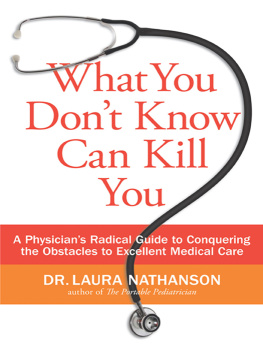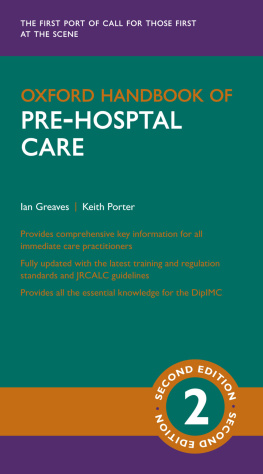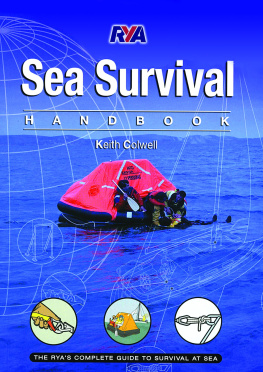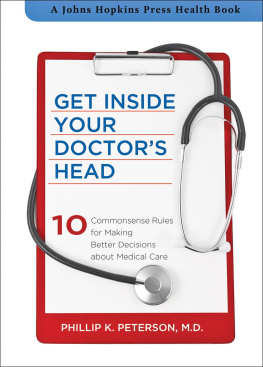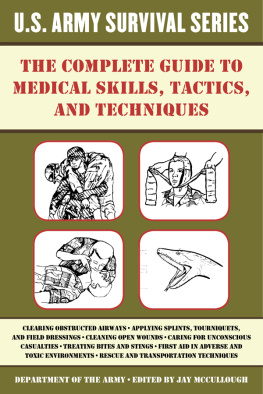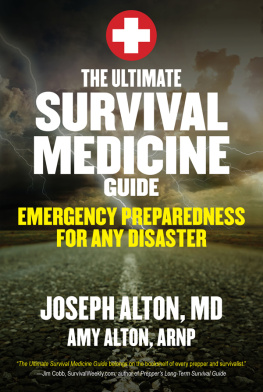NOTE TO OUR READERS
The information in this book should not be substituted for, or used to alter, medical therapy without your doctors advice. For a specific health problem, consult your physician for guidance. If youre in a life-threatening or emergency medical situation, seek medical assistance immediately. This book is sold without warranties of any kind, express or implied, and the publisher and author disclaim any liability, loss, or damage caused by the contents of this book.
CONTENTS
To Pam, my best friend forever, who also happens to be my wife. And to the greatest daughters a man could ever wish for, Leigh Ann and Beth. And to the newest love of my life, my grandson, Michael. Whatever good there is in me, its because of God and my family.
PREFACE
Its the worst snowstorm you can remember. The ice-covered streets are abandoned. You hear a boom in the distance, and your computer screen goes blank. Darkness. A crash and another bang from inside the house. In the hallway, your husband sits on the floor, soaked in blood. You dial 911, and all you get is a busy signal.
If someone needs immediate, advanced medical care, we usually expect a highly trained team of EMTs and paramedics to show up within minutes and take it from there. In my medical office, if I call for transport and am not hearing a siren by the time I put down the phone, I wonder whats wrong. But Im also old enough to remember that this hasnt always been the case, especially in areas away from big cities. And its not always the case today. If you had to wait hours for help, would you know what to do?
Almost daily were inundated with news of terrorist attacks, riots, and natural disasters like hurricanes and earthquakes. Reports keep coming in about emergency medical services being understaffed, causing life-threatening delays in 911 response. Then there are times when youre hiking, hunting, camping, or just traveling on a lonely road with no cell-phone service and no other humans for miles. Even in the best of times, those first few minutes before an ambulance arrives are crucial. If you know a few basic medical techniques, your help could mean the sole difference between life and death.
The typical first-aid book gives you the basics. But in this book I go furtherto give you medical information I believe everyone should have when expert help is not on the way.
Give this book an easily accessible, always-know-where-it-is space on your shelf. Better yet, keep it in your emergency kit. Even better, buy several copies and stow one in your car and one in your office. And read it through once or twice.
Of course, in no way am I suggesting this information should take the place of evaluation and treatment from health care professionals if available. In addition, even though this book is focused on self-help, youll see instances throughout when I do say its important to get care if possible. Thats because there are times when help is difficult but not impossible to getperhaps via helicopter or a long hike. If you know an injury or illness is immediately life-threatening, and youre without advanced care, machines, and medicines, this book will help you decide what to do and how quickly to do it.
This is not only life-saving knowledge, its also life-changing. Youll feel confident and empowered, knowing that you better understand your body, some of the scariest things that can go wrong with it, and how you can help treat these conditions if disaster strikes.
PREPARE YOURSELF
POP QUIZ
A booming storm woke up a mother in the middle of the night. She fumbled for the light switch and discovered the electricity was out. On her way to check on her children, she tripped in the darkness and hit her face on the wall, also hurting her wrist somehow.
She told me this story as she sat on the emergency room table, drenched, holding her nose with a blood-soaked cloth and totally disgusted about the whole situation. But what if she couldnt have gotten expert help? What if the storm had knocked out the phones and felled trees onto the roads? What should she have done?
A. Put an ice pack on her forehead to stop the nosebleed.
B. Not worry about her wrist if she could move her fingers. That would mean there were no broken bones.
C. Gotten someone to find her copy of this book, stored in its usual place in her safe.
D. Run outside and bang on the neighbors doors, screaming, Is there a doctor in the house?!
ANSWERS
A. Incorrect. Ice might help cut down on the blood flow, but the main thing to do is apply direct pressure to the most likely source of the bleeding. In the case of your nose, that means pinching just below the nasal bone. And keep the pressure constant for a good five minutes or more, so the blood will have time to clot. Oh, and never leave ice directly on the skin for more than a couple of minutes unless you have it wrapped in something like a cloth. Otherwise you could create your own self-made version of frostbite.
B. Incorrect. Moving your fingers, toes, or anything else might help you decide whether theres muscle, tendon, or joint damage, but it wont tell you a thing about whether a bone is broken. Nothing. Nada. Its a myth (See ).
C. Correct. see for more on safe rooms.
D. Incorrect. I hope you didnt choose D, unless you know your neighbors, they dont own guns, and they know you quite well and like you very much.
DONT GET CAUGHT BY SURPRISE
Have you ever been to the grocery store before a storm? The milk, bread, and bottled water shelves are empty, and people are running around like chickens with their heads cut off, grabbing whatever is left. You can feel the panic in the air.
Others who have gotten ready ahead of time are safe at home with their feet propped up, drinking herbal tea. Theyve had time to smooth out important details with a level headthings like shuttering the windows and making sure everyone is accounted for. When it comes to emergencies, theres no better advice than the Boy Scout motto, Be Prepared.

PREPARATION TIPS
Imagine a sudden catastrophe. No time for the store. Thinking is shifted to fast mode and clouded by the impending and immediate danger. If youre not prepared, chances are youre going to forget something, maybe something important.
TIP 1: TAKE SURVIVAL OF THE FITTEST SERIOUSLY
Maintaining optimal health and fitness is one of the best things you can do, not only for your health but also to be ready for an emergency. Aerobic and weight-bearing exercise should be a priority in your daily life. Who knows when you may need to run for shelter with a child in your arms or perform CPR on a neighbor?
Eat nutritious food and get your sleep. These are the best ways to build up your immunity. Keep your weight under control. Stop smoking. Get regular physical exams. Then, even if you get sick or hurt during a disaster, you have a better chance of surviving.
TIP 2: REMEMBER, PRACTICE MAKES PERFECTWELL, ALMOST
Health care professionals train for potential emergencies as a team. We practice drills until we can perform them without thinking. When someone comes in unconscious or seriously injured, we dont have to stand around pondering what to do. We even have equipment placed where we can find it without looking.


